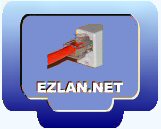|
EZLAN.NET
Copyright © 2001-2007
|
Hardware and Software Specifications, Examples, Links, and other info. are valid at the publishing time. In case it become invalid use the Internet Search. 1st Published, April 2005 Over 6,500,000 Hits Site Wide in 2006. 
Hi Gain Antenna for Entry Level Wireless. Antennae come in variety of build
and quality, a better Antenna can propagate the signal better. However better Antennae (or any Antennae that can be installed on regular Wireless
Instruments) are not amplifiers, they can Not boost the power of the transmission. The Antenna takes the energy from the power
amplifier of the instrument's Transmitter and propagates it into the air, if it is a better quality Antenna it would propagate
better and might improve the distance. The differences in Antennae quality and build
is reflected in dbi rating. Dbi is a relative measure unit, it reflects the Antenna capacity to provide a better signal than a standard dipole antenna
that is cut to the measure of 1/4 size wave length of the frequency that it is designed for (or the center of the frequency in
case of range). It is important to understand that the rating of an Antenna does not reflect the exact functional outcome. If a 2dbi Antenna provides a working Wireless distance of 50 feet. A 4 dbi Antenna would extend it to 100 feet. Getting a better designed Omni Directional Antenna
(which is usually in the 4-8 dbi range) might improve somewhat indoor propagation, but it is usually a minimal improvement and
might results in a gain of few feet. In an Indoor envioroment there are many obstructions that absorb the Wireless signal and a better Antenna would not
provide a signal to the extend that would overcome these absorptions. Uni-Directional Antennae are much more suitable to outdoor bridging. With a direct line of site and a Good Uni-Directional Antenna you would be able to Bridge Hundreds of feet (might be even few miles if the Antennae are installed on high towers). Wireless Hardware usually come with the Antenna
attached directly to the output plug of the unit. Some times better propagation might be achieved by placing the Antenna in
a better location. To do so you need to have a Wireless unit with a removable external Antenna and you need an Extension Coax cable. Unlike Network CAT5e
cables that can carry the Network Signal for few
hundreds feet without significant loses, a typical Coax that is used for 2.4GHz Wireless loses 4db per 10 feet Professional installers prefer to install additional Access Points with the antenna attached directly to it and use CAT5e to connect it to the Network, and thus avoid the use of Coax. It is preferable to put a better Antenna on the transmitting source (Wireless Router / Access Point) than on the receiving end. By putting it on the source you can improve the General coverage. If you have a stationary Wireless client computer you can enhance its reception by putting a Uni-Directional Antenna pointing toward the source. To enhance stationary Bridging it is advisable to use a good directional Antenna on both end of the Wireless Bridge. The best solution to extend the distance of indoor Wireless Network is to extend coverage by adding more transmitters. I.e. Access Point Repeaters, etc. You can find more about Wireless
effective distance in the following pages.
|